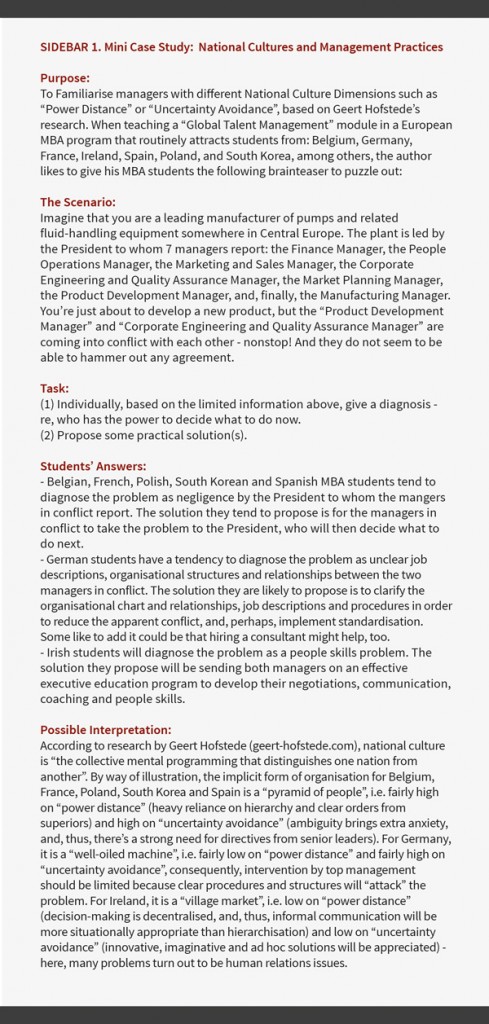By Bart Tkaczyk
Attract the best people. Own shares either in good ships, or in none at all. Make your ship attractive, then good people will join it and it will be well manned.– from The Vikings’ Guide to Good Business: On How to Do Business Overseas and Succeed (translated from the original 13th-century text by Bernard Scudder).
This article champions three integrated sets of strategic choices for multinational corporations (MNCs) to consider when crafting a choiceful People Operations strategy to win against their very best competitors – internationally. Specifically, they are: resourcing and staffing for overseas operations (Choice Set 1), managing diverse talent (Choice Set 2), and coordinating mechanisms (Choice Set 3). These choices must be connected to other strategic choices in the firm.
STRATEGY IS CHOICE
There is no such thing as a perfect strategy. Nor does it guarantee that intended outcomes will be achieved. In general, strategising is as messy as it is energising, as dissatisfying as it is fulfilling, as a creative process as it is a rational, rigorous and scientific one. While this is true for many domestic organisations, there are even more sensitive dichotomies and complex dilemmas with which multinational corporations (MNCs) need to wrestle, e.g. “Globalisation vs. Embeddedness”, “Convergence/Integration/Synergies vs. Divergence/Differentiation/National Distinctiveness”, “Structures” (Virtual Enterprise vs. Co-location vs. Satellite Labs vs. Independent Agents vs. Licensing Arrangements vs. Branch Offices vs. Strategic Alliances vs. International Joint Ventures vs. Foreign Direct Investment), “Standardisation vs. Segmentation”, “Cultures vs. Institutions”, “Neutrality vs. Affectivity”, “Indulgence vs. Restraint”, “Individual Recognition vs. Group Rewards”, “Achievement vs. Ascription”, “Possibilities/Resources vs. Constraints/Barriers”, “Collaboration vs. Competition and Power Struggles” (Edwards & Rees, 2011). Instead of pretending that they do not come about, it is critical to recognise these tensions – and confront them head on, identifying what they are, and how they can be strategically managed.
Strategy is a developing area, and there is little consensus on the definition of what exactly constitutes strategy. Further, companies often confuse “operational effectiveness” or management methods as a continuous process improvement (CPI) or a total quality management (TQM) – which is imperative but is not enough or do not necessarily indicate superior or sustainable profitability – with “strategy”. According to Michael Porter, a leading strategy thinker, “operational effectiveness” is about “performing similar activities better than rivals perform them” (Porter, 1996, p. 62) – this often includes efficiency, reducing waste (Lean) or defects in products (Six Sigma), or producing them faster (it was the Japanese who sparked a global shake-up in operational effectiveness in the 1970s and 1980s), whereas “strategic thinking” means “performing different activities from rivals” or “performing similar activities in different ways” (Porter, 1996, p. 62). This article adopts Porter’s classic definition of strategy which explains that a. Strategy is the creation of a unique and valuable position, involving a different set of activities, b. Strategy requires you to make trade-offs in competing – to choose what not to do, and c. Strategy involves creating “fit” among a company’s activities (Porter, 1996). Accordingly, strategising is all about making real strategic choices, to explicitly choose what to do, as well as to choose what not to do, and developing an organisation around these hard choices – which is to create value. In point of fact, for A.G. Lafley, former CEO of P&G and Roger Martin, former Dean of the Rotman School of Management (Lafley & Martin, 2013), strategy is the answer to the five questions [by way of illustration, example answers from a fictional strategic advisory firm are given in brackets]:
1. What is our winning aspiration? [e.g. We exist to mobilise executives and aim to be the strategic advisor of choice for CEOs and business leaders in the Middle East.]
2. Where will we play? [e.g. Strategic advisory services to the C-suite in Bahrain, Kuwait, Qatar, Saudi Arabia, and the UAE.]
3. How will we win where we have chosen to play? [e.g. We will try to understand our clients’ needs and expectations deeply by means of high-quality, strategic collaboration, cutting-edge approaches including ethnographic and neuroscientific research methods, and, therefore, offer services to our clients, delight, and “shield” them vigorously from competitors. We will not constantly drive costs down.]
4. What capabilities must be in place to win? [e.g. Valuable and agile Human Resources, embracing diversity in all forms, research-based practice, constant learning and development (L&D), boutique relationships, a business model which mixes consulting and investing.]
5. What management systems are required to ensure the capabilities are in place? [e.g. Global talent management strategy, diversity management strategy, proactive recruitment channels, knowledge management information system, integrated talent development strategy, 70-20-10 learning framework, corporate “evangelisation” program, authorised distributors and strategic partnerships, investment appraisal and transaction execution system.]
PLAYING TO WIN RATHER THAN PLAYING TO PLAY:
3 Strategic Choice Sets for People Operations on the Global Playing Field
Leaders go all out to craft the game-changing formula for their enterprises to win against their very best competitors, internationally. Although People Operations (you probably know it better as “Human Resources”) are not the basis of all business activity, People Operations are the basis of all management activity. Therefore, when playing to win, rather than playing to play, on the global playing field, enterprises should make real strategic choices when it comes to international people operations.
My purpose here is to propose the Strategic People Operations Triangle (SPOT), specifically, three integrated sets of strategic choices for multinational companies (MNCs) to consider when crafting a People Operations strategy, a choiceful management system framework mixing strategically: Resourcing and staffing for overseas operations (Choice Set 1), Managing diverse talent (Choice Set 2), and Coordinating mechanisms (Choice Set 3). Before anything else, it is practical to consider strategic choices on two strata: they are either “make-or-break” choices (they play a part in supporting the organisation’s economic viability) or they account for ongoing enterprise performance differentiation. Also, these choices must be connected to other strategic ones in the firm like Talent Development, and so on. The following section illustrates the strategic choice-making (for quick reference, every strategic Choice Set is also accompanied by an explainer Table).
Choice Set 1: Resourcing – Staffing an Overseas Operation
When companies fix on going international (which is a key choice itself, i.e. “stay domestic” vs. “go international”), they need to have highly selective recruitment to decide on whom to appoint to manage their operations, plants or other units outside of the “parent country”. There are at least five strategic staffing choices for an overseas operation, i.e. the “ethnocentric” way (filling key positions with executives who are “parent” country nationals), the “polycentric” approach (hiring extremely good individuals who are “host” country nationals), the “hybrid” way (filling key positions with managers from the “host” country who are also of “parent” country ancestry, or “parent” country nationals who are of “host” country ancestry), the “regiocentric” way (selecting management personnel from within a region of the world which most closely resembles that of the “host” country) or the “cosmopolitan” way (appointing senior leaders from a “third’ country”, i.e. the most appropriate managers used who are based literally anywhere and happy to re-locate). These five approaches accompanied by some examples of advantages (+) and disadvantages (-) are summarised in the Table 1 I developed (partly based on Deresky & Christopher, 2012) for the purpose of teaching “Global Talent Management”, a course in a European MBA program.
Choice Set 2: Managing Diverse Talent
Globalisation and demographic change are making the workforce even more diverse. Therefore, it is critical for enterprises to develop equality and diversity to attract and retain talent to improve business performance and sustained competitive advantage.
The essence of much HR work is to actually discriminate between people fairly, but not unfairly! For instance, let’s take compensating human resources. Whenever one person is given a pay raise and another is not, the enterprise has decided to distinguish one person from another. As long as the basis for consistent and objective discrimination is purely job related (made, for example, on the basis of performance ratings, tests or 360-degree appraisals), the action is legal and appropriate. Problems begin when distinctions between employees are not job related, but are based on prejudice about classes of individuals. In such cases, the discrimination is illegal and inappropriate.
The essence of equality is to avoid unfair discrimination in the workplace. There are two main approaches to equality: Equal Opportunities (EO) and Diversity Management (DM). The former approach emphasises equality of opportunity rather than equality of outcome, and seeks to control behaviour through legislation. Yet, legislation does not protect all minority groups, may not change cultures or, even worse, it can alienate large sections of staff. The latter strategy, although slow to materialise and more complex to interpret and execute, concentrates on individuals rather than groups, and, thus, separate groups are not singled out. Unlike the EO approach, the DM approach highlights the economic and business case (See Table 2, which I developed for an MBA module in Strategic HRM; it captures the differences between the two approaches in detail).
Importantly, everybody is a unique person. Although we have things in common with each other, we do differ in many ways too. Distinctions comprise, for example, personal qualities as background, character, work-style, culture, personality, perceptions, language and accent. Diversity should embody inclusion. Hence, to strategically capitalise on human capital assets fully, real inclusion should go beyond the so-called “protected characteristics”, e.g. gender reassignment, sexual orientation, pregnancy and maternity, or religion and belief. It should be about bringing in people from across sectors, cultures, experiences, demographics, generations, intelligences, insights, relationships, and backgrounds.
In fact, nurturing a culture of diversity and organisational integrative thinking where opposing ideas grate up against each other, is an essential factor in innovation execution (conflict may be key to team cohesion too). This fosters “creative abrasion”, i.e, diversity in thinking style, a term by Jerry Hirshberg, founder and president of Nissan Design International, that explains a dynamic culture where ideas are creatively and constructively challenged. Therefore, to make innovation happen, you must staff, collaborate with, and promote people who are unlike you. Steve Jobs forever advocated “creative abrasion” in the workplace. For example, when working on the Apple Mac initiative, he assembled a dedicated team of individuals who were intentionally diverse and who were able to simultaneously hold opposing models in mind, while still being able to operate. He engaged poetry writers, performers, historians, designers who also happened to be extremely smart engineers. In doing so, he formed a strategic partnership where choicefulness, opposing cognitive biases, unorthodox problem-solving ways, learning and diversity in thinking styles mixed successfully and were the norm (On choicefulness and integrative thinking, see Martin, 2009, and Moldoveanu & Martin, 2010).
The bottom line is, managing diversity means valuing every person as an individual – valuing people as employees, customers and clients.
Choice Set 3: Coordinating mechanisms
Leaders should energise a diversity of local activities to relate to the local environment. By contrast, their global strategising calls for coordination as the way to interaction and cooperation of the global and the local together so as to produce a combined effect greater than the sum of their separate effects. There are at least four strategic approaches to coordination, conventionalised as: “American” Formalisation, “European” Socialisation, “Japanese” Centralisation, and Universal “Evangelisation”. For some characteristics, see Table 3 which I developed (partly based on Bartlett & Ghoshal, 2002) for the purpose of teaching a “Global Talent Management” course in one European MBA program. Also, see Sidebar 1 for a Mini Case Study on how “national cultures” impact human behaviour and management practices.
IN CLOSING
Singly, these instances of strategic choice sets and People Operations management systems may not prove a great deal. Taken together and effectively aligned with the broader business and organisational strategies, however, these choices are inevitably connected to the enterprises’ performance and competitiveness, and will increase the odds of success. As People Operations strategy is too important to leave to chance, it is the global leader’s principal role to craft it, which combines rigor, as well as creativity. To strategise to win, multinational companies (MNCs) should have a choiceful People Operations strategy in place.
 Bart Tkaczyk is a Fulbright Scholar at University of California, Berkeley. He is also in the business of energising extremely good leaders around the globe to aim even higher. On Twitter: @DrBTkaczykMBA
Bart Tkaczyk is a Fulbright Scholar at University of California, Berkeley. He is also in the business of energising extremely good leaders around the globe to aim even higher. On Twitter: @DrBTkaczykMBA
References
1. Bartlett, C., & Ghoshal, S. (2002). Managing across borders: The transnational solution. Boston: Harvard Business Review Press.
2. Deresky, H., & Christopher, E. (2012). International management: Managing cultural diversity. Frenchs Forest, NSW: Pearson Australia.
3. Edwards, T., & Rees, C. (2011). International human resource management: Globalization, national systems and multinational companies. Essex: Pearson.
4. Govindarajan, V., & Trimble, C. (2012). Reverse innovation: Create far from home, win everywhere. Boston: Harvard Business Review Press.
5. Hofstede, G. Available at: http://geert-hofstede.com/
countries.html
6. Lafley, A.G., & Martin, R. (2013). Playing to win: How strategy really works. Boston: Harvard Business Review Press.
7. Martin, R. (2009). The opposable mind: Winning through integrative thinking. Boston: Harvard Business Press.
8. Moldoveanu, M., & Martin, R. (2010). Diaminds: Decoding the mental habits of successful thinkers. Toronto: Rotman/University of Toronto Press.
9. Porter, M. (1996). “What is strategy?” Harvard Business Review 74(6): 61-78.
































![“Does Everyone Hear Me OK?”: How to Lead Virtual Teams Effectively iStock-1438575049 (1) [Converted]](https://www.europeanbusinessreview.com/wp-content/uploads/2024/11/iStock-1438575049-1-Converted-100x70.jpg)




